Hunting Laetiporus sulphureus, The Sulfur Shelf or Chicken Mushroom
one of the (so far) few harvest delights that’s appropriately abundant, and very welcome it is. Here’s the lowdown from out resident mushroom expert:
BRIGHT HARBINGER OF FALL, Laetiporus sulphureus: AKA The Sulfur Shelf or Chicken Mushroom.
What a dismal summer! Here it is Labor Day and farmers have yet to complete their first cutting of hay. Late blight destroyed many a tomato crop and those not affected have all of the taste and consistency of wet cardboard. Corn here in Maine is but knee high.
Behind the fields the fruits of the forest have also languished. Perhaps it was the long stretches of cool wet weather that put a stop to the saprophytic mushrooms, for few litter- decaying fungi of any species appeared in the coastal forests near us. Scant too were the usual mycorrhizal species of summer: the Amanita, Russula, and Lactarius.
But in the last few days, walking along the bench of a nearby mountain, and again at the edge of a large lake, there came a sight that warmed my heart and seemed ready to fill the cusp of autumn with promise and pleasure: Sulfur Shelfs, bright as neon, sprouting buds with flesh as tender as brie, scent fragrant as a ripe peach.
Can any mushroom better announce the approach of the equinox than the Sulfur Shelf? It heralds the end of summer with a burst of beauty and energy that stops us dead in our tracks. “Here it is. Here I am” it seems to say. “Get ready, we are about to turn that corner into a bright and bountiful fall”.

The Sulfur Shelf, bright harbinger of fall
Edibility and Taxonomy of the Sulfur Shelf:
When I was growing up, the Sulfur Shelf was known as Polyporus sulphureus and was universally considered safe and edible. Most field guides published in the last half of the twentieth century in fact rank it as ‘choice”. The authors were following the lead of Clyde Christiansen, University of Wisconsin mycologist, who popularized it (along with the Morel, Giant Puffball, and Shaggy Mane) as one of his “Foolproof Four”: Beginners couldn’t mistake these for any other mushroom, there were no toxic look alikes, they were widely collected and eaten, sold at farmers markets across the country and unless you had an allergy to them, you wouldn’t get sick if the mushroom was well cooked..
This was pretty much the accepted wisdom well into the 1980’s. By this time, however, a number of cases had presented themselves where “allergic reactions” occurred, and a pattern seemed to appear indicating that Sulfur Shelf mushrooms growing on certain trees and in certain areas were more likely to cause allergic reactions and gastric distress than others. Eucalyptus, Evergreens, and Locust in particular were suspect and the advice began to be published to avoid eating mushrooms collected from these trees.
By this time also the Sulfur Shelf had been transferred out of Polyporus into a new segregate genus, Laetiporus, based in part upon wood rotting characteristics (see below). During the 1990’s the use of new genetic and mating techniques led to the discovery that the single species Laetiporus (Polyporus) sulphureus could be segregated into five or six separate species. For more, see here and here.
As it turns out, those Sulfur Shelfs living on eucalyptus and evergreen are genetically distinct from L. sulphureus, even though they are morphologically identical, and what was once thought to be a single safe species turned into a complex of species, some of which apparently could be quite troublesome.
Wikipedia lists five genetic groups:
1.One group grows on conifers: the Conifericola clade L. conifericola and L. huroniensis, and the four following groups grow on hardwoods.
2. Cincinnatus clade: contains L. cincinnatus
3. Sulphureus clade I: contains white-pored L. sulfureus isolates.
4. Sulphureus clade II: contains yellow-pored L. sulfureus isolates.
5. Gilbertsonii clade: contains L. gilbertsonii growing on Eucalyptus and unidentified Caribbean isolates
For collectors in the Northeast this complexity can be simplified if we first eliminate those species which grow on conifers. (Hemlock, Spruce, Pine and other evergreens) Those with restricted ranges to the west coast and the Caribbean sort themselves out geographically and we are left with L. cincinnatus and the two varieties of L. sulphureus (2, 3 and 4 above).
Both species grow primarily or exclusively on Oak, an important consideration for those of us who collect for the table. The current advice then is to collect Sulfur Shelf Mushrooms only from identifiable, still standing or recently fallen Oaks.

Sulfur Shelf on Oak
L. sulphureus has a rich orange velvety top and a lemon yellow pore surface. It tends to spring from wood above the butt region.

L. sulphureus. Young specimens such as this make for the best eating.
L. cincinnatus has a pinkish upper and white lower surface. It is thought to grow primarily in rosettes at the base of the tree, often from the ground. It is also considered the more tender and edible of the two.
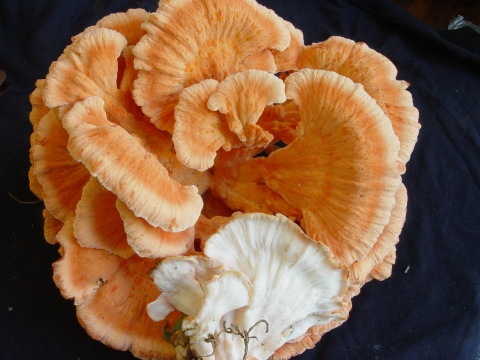
A rosette of L. cincinnatus
Polyporus sulphureus var semialbinus (Peck) is sometimes thought to be a transitional or ‘hybrid’ form of L. sulphureus.
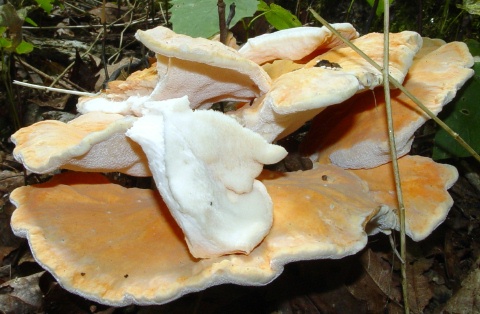
Polyporus sulphureus var. semialbinus, as described by Charles Peck
So, if you are collecting the Sulfur Shelf for the table, you might follow these guidelines. Collect only young specimens, from Oak trees which have not been treated with chemicals (used perhaps in a futile attempt to prevent rot – see later) and cook the mushroom well. On mature specimens only the tender-most outer edge should be eaten. Old, faded, woody, bug infested specimens should never be eaten. Test a small portion, without alcohol, until you can establish that this mushroom agrees with your own biology. These are standard rules for the testing the personal edibility of any new mushroom. See The Long-lived Mushroom Eater’s Golden Rules for more. If you hang around mushroom groups for any length of time you will also hear anecdotal stories of how the allergic reactions to this mushroom are either sex-linked, affecting women more than men, or potentiated by alcohol, or both. I could find no documentation of this assertion, but caution is advised.
Sulfur Shelf, “The Chicken Mushroom”
Many people refer L. sulphureus (and cincinnatus) as ‘The Chicken Mushroom’ because of its chicken-like texture. Many cooks maintain that it can be used in any recipe that calls for chicken. (This ‘chicken” should not be confused with another edible Polypore, Grifola frondosus, also known as “The Hen of the Woods“.
Years ago I was on a joint family camping trip with a vegan couple and our children. We set up camp at North Lake near Hunter Mountain in the Catskills and in the late afternoon took a short hike to view Katterskill Falls. At the falls the kids wanted to climb down and crawl along the trace of a trail which went down under the escarpment and into the shallow cavern behind the falls. On the descent, off the side of the path and in the spray of the falls lay a dead Oak from which we made a good collection of Sulfur Shelf, and from a nearby poplar, a similar collection of Oyster Mushrooms.
Back at camp the mushrooms were cooked up with pasta and greens into a suitable vegetarian repast for all to enjoy. As we settled back to enjoy the meal, Kathy, the vegan, tasted the sulphureus, began to smile, and then blush. She was transfixed, unable to continue, yet also unable to resist. In the struggle she became nearly beet red with a strange smile frozen onto her face. “It is just like Chicken”, she said. “I can’t believe it. I know it is the mushroom we just picked, but it is just like chicken. I can’t believe it!” She did finish the meal, although with what she described as “guilty pleasure”. Were all of our conflicts so easily resolved!
Brown Rot, White Rot, (and Soft Rot too)
Through the process of photosynthesis, green plants utilize the energy of sunlight to capture and break apart the Carbon Dioxide molecule. Forest trees fix the Carbon into organic compounds such as cellulose and lignin and release the Oxygen molecule back into the atmosphere. Fungi which lack chlorophyll are unable to gain energy directly from sunlight. Instead, like us, they must feed upon the organic compounds created by plants. They do so by releasing specific enzymes which digest the organic food material. The digestion takes place outside of the mushroom and has important consequences for both the trees and ecosystem. Fungi are well known as the primary recyclers in nature.
All Polypore fungi are lignicolous, that is, they make their living by digesting wood. Over the years, this large diverse group has been studied, refined and subdivided into a myriad of specialized groups. As mentioned above, the genus Laetiporus was constructed to segregate out of Polyporus a subset of fungi which have, among other things, a certain feeding style which leads to the accumulation of a brown, cube-like residue called Brown Rot. Other lignicolous mushrooms produce a White Rot and lower fungi produce a Soft Rot.
White Rot Fungi are able to digest both the simple cellulose and the much more complex lignin compounds. Cellulose can be broken down by a single enzyme, but lignin’s long multi-branched polymer poses special challenges and resists degradation. Instead of using a multitude of enzymes to break apart this complex structure the White Rot Fungi degrade it by a chain reaction oxidative process. “The details of this are complex, but essentially the white-rot fungi produce only a few enzymes (lignin peroxidase, manganese peroxidase, H2O2-generating enzymes, and laccase) and these generate strong oxidants, which virtually “combust” the lignin framework”. More about this here. This is still comparatively ‘slow oxidation’ and does not release energy anywhere near as quickly as does a campfire, but the tree becomes consumed from the inside, quickly looses weight and mass by this combustion and collapses into a soft white pulpy mass.
Brown Rot Fungi, like Laetiporus sulphureus, are able to degrade only cellulose (and hemicellulose) and leave behind a brown residue, the inner walls of the trees cells, comprised of lignin. Often a brick-like cubic structure is seen in the residue which is therefore called Cube Rot. As this process occurs, the tree becomes weaker and less able to bend in the breezes. It does not loose weight as quickly as it looses strength however, and usually snaps apart near the lower part of the trunk.
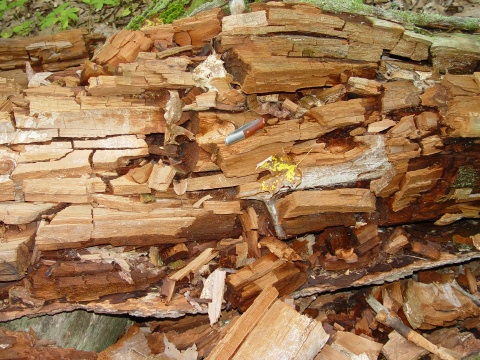
Oaks degraded by Brown Rot fungi such as L. sulphureus show this characteristic cube like structure as they progress from sound wood to the rich dark humus of the temperate forest floor.
The lignin remains of Brown Rot become the stuff of new soil on the forest floor. As it happens, Laetiporus sulphureus usually destroys the tree even before the mushroom is able to fruit. At the same time, however, it is initiating the process of rebuilding the soil so that forest life continues anew.
Whereas White and Brown Rot are decay processes initiated by macro-fungi, Soft Rot is produced by lower filamentous fungi. No mushrooms are involved. These fungi require constant moisture to ensure that their naked cells survive. Ground contact is usually involved, from which these lower fungi obtain nitrogen necessary for their digestive process. As the organic matter decays, it often develops cavities within the cell, and becomes soft and soggy before collapsing under environmental weight. One can often see this Soft Rot in house sills and at the base of fence posts.
If you think about these digestive strategies for a while, you might begin to wonder how the cell walls of the mushroom remain intact during this process of enzymatic degradation. The answer is that the cell walls of mushrooms are not made of cellulose, but of chitin, the same material of Lobster shells, and therefore are not degraded by the enzymes which degrade cellulose and lignin. This is also why fungi are often hard to digest and one reason why they must be well cooked before consumption. Many ‘toxic reaction’ to mushrooms are apparently caused by undercooking. In addition to the hard-to-digest chitin, other specific toxins are also found in some fungi, many, but not all of which are destroyed by cooking.
Strategies for finding Sulfur Shelf Mushrooms
Strategies of hunting for Sulfur Shelf fungi are identical to those described for hunting Grifola Frondosus, The Hen of the Woods. If you haven’t already done so, you might want to consult the guide on the Hen of the Woods post mentioned earlier.
A good strategy is to search out old Oak trees in relatively undisturbed forests such as Estates, old Cemeteries, Parks, Steep hillsides in Forest Preserves and Line Trees bordering such areas. A slow drive down country lanes will often reveal the presence of old Oaks worth investigating.
Once a fruiting has been found, you can return in subsequent years for the perennial fruiting of the mushroom. If you know the location of a few trees, you can often find more by moving from one infected tree to the next, examining the forest for newly infected trees. Pay particular attention to old Oaks that have a crumbly, chalky, white mass at the base of the tree. These are the decayed remains of last years Sulfur Shelf Mushrooms.
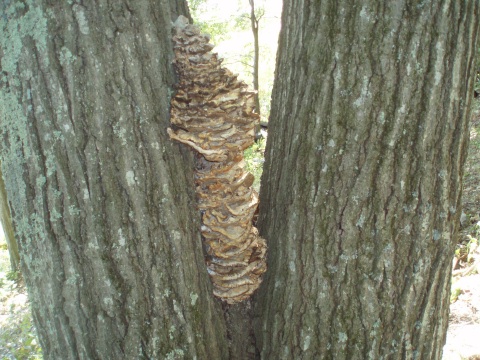
In this image you can see how the Sulfur Shelf shown above has aged

And here are the white chalky remains of a sulphureus from the previous season. Nothing to collect, but a place to remember and to visit in the future.
It pays to use a pack basket or large creel, perhaps with an additional cloth shopping bag tucked inside for the serendipitous find. A good tree can produce fifty or more pounds of choice mushrooms.
I know Leslie will want to include her own recipe, but in the meantime here is an illustrated guide to preparing creamed Sulfur Shelf over pasta. Of course, if you are in a hurry sautéing slivers in butter makes for a fine sandwich and is a preferred way of testing almost any new mushroom.
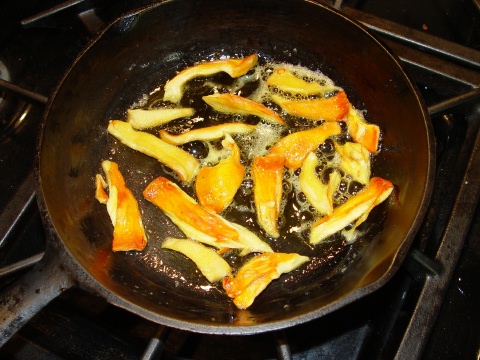
L. sulphureus sautéed in butter, a time honored way to test a new mushroom

Combined with grilled pork chop, this Sulfur Shelf made a great sandwich
Good Hunting and Bon appétit!
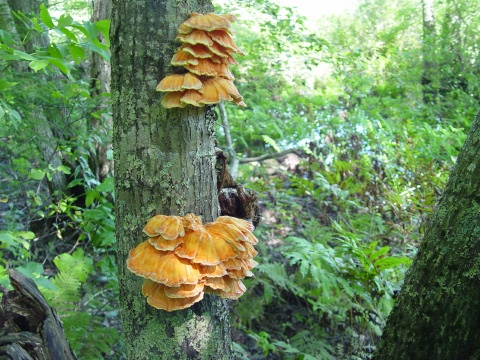















Anyone have any ideas on drying sulphur mushrooms ????
Hi Frazer,
Maybe someone – please weigh in, folks! – will have a special technique for drying sulfur shelf and/or a recipe that uses them well that way, but as far as I know they’re not good candidates for drying. Too thick. If you slice them thinly they lose their character and if you don’t they turn to wood that does not reconstitute pleasantly. The firm, meaty but tender texture is one of sulfur shelf’s nicest aspects, so preserving that is part of preserving them.
We do the usual saute in butter and freeze, but that’s partly because I never met a pickled mushroom I wanted to take a second bite of. Plenty of other people like pickled mushrooms just fine, though, so if you’re looking for off-the-grid methods you might want to try it. Otherwise, the way to use solar power on these mushrooms is to make electricity out of it, and that should be right down your alley.
ed or leslie (not sure since i see the same message above) i’ve been told that you can par boil them (i haven’t tried that yet, but i plan too this fall). otherwise we’ve used them in cream of mushroom soup and mushroom pate’ following any recipe you get your hands on you’ll have to macerate the shrooms in a food processor anyway and that alleviates the toughness. i’ve done both recipes with success. good luck
I was wondering if anyone knew how fast the chicken mushroom grows. I found some today but just came out. I was not sure when to go back and check on them?
Hey Kimberly,
1. Culinary answer: Since they are best when in the young ‘cream cheese’ stage, get yourself back there pronto. You won’t be disappointed.
2. Mycological answer: The mushrooms which erupt from the fields and forest floors following a rain are comprised of a single type of cell structure, one which inflates quickly under water pressure. This is called a ‘monomitic’ structure; the cells are usually referred to as ‘generative’. Mushrooms of this type come up quickly, and also decay quickly.
Polypores have two (dimitic) or three (trimitic) kinds of cells; the rapidly expanding inflatable generative cells, along with two kinds of reinforcing cells, referred to as ‘binding’ and ‘skeletal’. The hard woody conks you see on trees are almost certainly trimitic. This is why they resist decay.
The genus Laetiporus has a dimitic structure, the quickly expanding (and tender) generative hyphae, and the more rigid, slower growing binding hyphae. When you collect it in the soft ‘cream cheese’ stage you are getting the fruits of the generative tissue. As the mushroom matures a higher and higher percentage of the cells will be of the tougher binding type. These cells give the fruiting body strength and rigidity and can even hold it together after the softer generative tissue dries out and collapses.
The speed at which this process occurs is partially a function of environmental factors such as temperature and humidity.
As a practical matter, when collecting for the table, if you miss the very young stage the advice is to collect only the tender -still expanding- tips of the shelves. I find the useable ‘shelf-life’ of these chickens to be about a week in length. But since new growths often appear in tandem, the tree may continue to produce edible mushrooms for another week or so, and may (rarely) fruit more than once a season.
I hope this helps.
I can mine, according to green bean directions. Then in winter I drain and SAVE and the broth from them, put some olive oil in iron skillet, add flour and parsley, stir the broth in the gravy and put the already “cooked” peices into it. Whoa! Did ever fool my bro, the vegan.I served it over rye toast.
Thank you. That was extremely helpful. I did not pick it because it was so small but I am heading back there tomorrow. I hope I am not too late:-) I often get the Honey’s which need to be picked as soon as they come up or the Hen of the Woods which I let grow for awhile. Thank you so much!
Great definitive and informative article, thank you!
I’ve always suspected that when someone started looking close enough that they’d find more than one species.
I’ve always wondered if the A. casearea (sp?) is a unique and different species from the widely eaten European one.
thanks for the info very helpful too me
Hello all, this is the website I’ve been looking for!
I was in Ocala, FL yesterday and found what I’m sure is a
sulphur polypore. I am brand new to finding wild mushrooms
so I’m very cautious about eating anything I find. Could I
attach a picture of this probably too mature chicken of
the woods for a conformation of what it is?
Hi John, and welcome to the blog. It’s always great to hear that people far from our Northeastern home are finding useful information, but mushrooms differ so much from place to place we don’t offer opinions about mushrooms collected outside of our local area.
Mushrooms not only differ markedly from region to region,but also from host to host, and season to season. Also, identifying from photographs is difficult; the eye can be fooled even when the specimens are in perfect condition and taken with professional equipment from appropriate angles.
Because of all this, we don’t try to do ID’s, and (for security reasons), we don’t open the images readers send us, tempting though it often is.
We suggest you contact The Gulf States Mycological Society at http://www.gsmyco.org/. They would have a much better chance of helping you to identify your mushroom correctly, and you are wise to seek expert consultation before you attempt to eat any of your finds. Quite often a ‘safe’ mushroom can pick up toxic resins from its host. The folks at Gulf States are the ones who would know things like this about the mushrooms in your area.
Good luck,
Bill
I love these and am cooking them now. we hunt many shrooms, we like the oysters, bolea <~~not sure of the spelling, of course morels. We have even tried the fawn mushroom and the turkey tail. we keep going out and keep living. We just found goat's beard, just a tiny bit but I am excited! I want to try hen of the woods. we keep looking, hey what kind of mushrooms to you knock out of box elder trees?